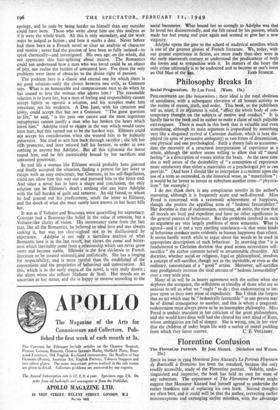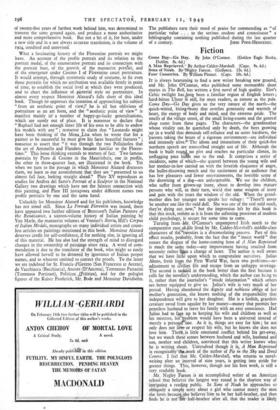. - •
Florentine Confusion
.Sitic:E its issue in 1924 Monsieur Jean Alazard's Le Portrait Florentin de Botticelli a Bronzino has been the standard, because the only readily accessible, study of the Florentine portrait. Voluble, undis- tinguished and imprecise, the book has held its own for' want of any substitute. The appearance of The Florentine Portrait might suggest that Monsieur Alazard had himself agreed to undertake the .rather thankless task of replacing his own book. Second thoughts are often best, and it could well be that the author, correcting earlier misconceptions and expunging earlier mistakes, with the advantage of twenty-five years of furthez work behind him, was determined to traverse the same ground again, and produce a more authoritative and more comprehensive book. But not a bit of it, for here under
a new title and in a not always accurate translation, is the volume of 1924, unedited and unrevised.
What a. fascinating history of the Florentine portrait we might have. An account of the profile portrait and its relation to the portrait medal, of the enumeratiwe,portrait and its connection with the portrait bust, of the growth of the mannerist portfait, and of the emergence under Cosimo I of Florentine court portraiture. It would attempt, through systematic study of costume, to fix even those portraits for which no attribution was available firmly in point of time, to establish the social level at which they were produced, and to chart the influence of ,fictorial style on portraiture. In almost every respect Monsieur Alazard's falls short of this ideal book. Though he expresses the intention of approaching his subject "from an aesthetic point of view,r. he is all but oblivious of portraiture as an art form, and the "aesthetic point of view" is manifest mainly in' a number of happy-go-lucky generalisations, which are surely out of place. It is nonsense to declare that "Raphael had not enough inner life of his own to be able to endow his models with any." ; nonsense to claim that "Leonardo might have been thinking of the Monas.Lisa when he wrote that for a painter to be successful he must give his faces beautiful features " ; nonsense to assert that "it was through the two Pollajuolos that the art of Antonello and Flanders became familiar to the Floren- tines." This loose thinking extends to matters of fact. Two famous portraits by Piero di Cosimo in the Mauritshuis, one in profile, the other in three-quarter face, are illustrated in the book. Yet when we turn to the passage in which Monsieur Alazard discusses them, we learn to our astonishment that they are "presented to us almost full face looking straight ahead." Plate XV reproduces as studies for Andrea del Sarto's Portrait of a Sculptor in the National Gallery two drawings which have not the faintest connection with this painting, and Plate III juxtaposes under different names two profile portraits by one and the same hand.
Unluckily for Monsieur Alazarlf and for his publishers, knowledge has not stood still. Since Le Portrait Florentin was issued, there have appeared two further editions of Berenson't Italian Painters of the Renaissance, a sixteen-volume history of Italian painting by
an Marie the mannerist volumes of Venturi's Storia, Hill's Corpus of Italian Medals, monographs on many individual artists and count- less articles on paintings mentioned in this book. Monsieur Alazard deserves credit for self-confidence, if for nothing else, in ignoring all of this material. He has also had the strength of mind to disregard changes in the ownership of paintings since 1924. A word of com- mendation is due to the translator of the book, who might so easily have allowed herself to be deterred by ignorance of Italian proper names, and to whoever omitted to correct the proofs. To the latter we are indebted for St. Francis d'Grezzo (San Francesco at Arezzo), de Vacchiacca (Bacchiacca), Ancofe (D'Ancona), Tommasso Partarim (Tommaso Portinari), Politicus_aolitian), and for the polyglot figures of the Kaiser Frederick, Mr. Bode and Monsieur Davidsohn. The publishers earn their meed of praise for commending as "of particular value . . . to the serious_ student- and connoisseur" a bibliography containing nothing published during the last quarter







































 Previous page
Previous page